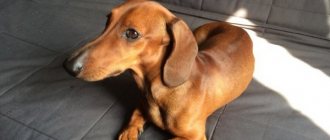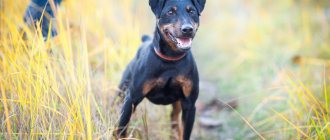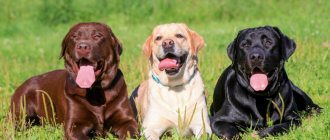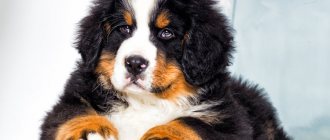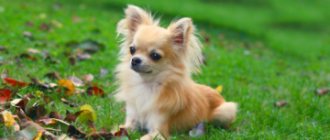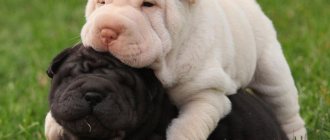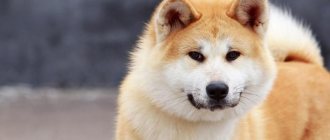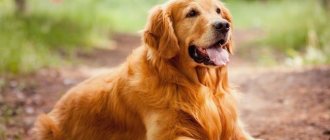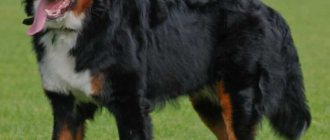The dachshund is an ancient hunting breed of dog.
It has only its own appearance with short legs and an elongated body.
Like real hunters, dachshunds are brave and resilient.
They know how to think logically, have intelligence and cunning.
As companions, dogs are cheerful and very sociable.
Photos of what newborn puppies look like
Puppies are born blind and deaf . React to pain, cold and touch. In the first week of life they only sleep and suckle. Healthy dachshund puppies feel dry and warm to the touch.
Babies cannot yet regulate their body temperature, so their place needs to be warmed up.
At three weeks of age, puppies are already active enough to explore their home..
Advantages and disadvantages of the breed
As with any other pet, you can highlight its positive and negative traits.
Positive traits of a dachshund:
- intelligence and ability to assess the situation;
- courage;
- equilibrium;
- playfulness;
- endurance;
- cleanliness;
- good security qualities.
Negative qualities:
- ability to be cunning;
- sensitivity to cold;
- weak spine;
- habit of digging.
All negative traits of the breed are eliminated by a loving owner in the process of education and proper maintenance.
When they open their eyes
Puppies open their eyes at 10-13 days . One eye may open before the other. After a week, the cub's gaze will be able to focus. At first, dogs only distinguish between light and dark.
Objects are seen dimly. During this period, puppies should be protected from bright light.
Good vision appears in the fourth or fifth week.
What you need to know about the breed: character, behavior
Before getting a taxi, the owner needs to know everything about dachshunds and their puppies. This is a hunting breed bred in Germany back in the seventeenth century.
The striking character traits and behavior of taxi drivers are:
- irrepressible energy, excitement;
- the desire to protect and protect the beloved owner;
- stubbornness. Dachshunds are quite capricious dogs, but this behavior can be corrected;
- high intelligence;
- Dachshund requires special attention. Otherwise, the pet will be offended by the owner and begin to behave inappropriately.
Dimensions and weight
Puppies are born quite large. Their weight in relation to the mother's weight is 7-8%. Dachshunds are growing very rapidly.
After a week they weigh twice as much as at birth, after two weeks - three times as much.
By the age of one month, the weight of puppies increases 7-8 times. One and a half month old babies weigh ten times more than newborns.
How it develops day by day in the first month
| Age | Stages of development |
| 1-10 day | Puppies are blind and deaf, but have a developed sense of smell and touch and respond to touch. They sleep and suckle their mother. |
| 4 day | Already knows how to find the mother’s milkiest nipples, knows her smell |
| 5 day | The nose is stained |
| Day 8 | The puppy weighs twice as much as at birth |
| 10-14 day | Eyes open, can crawl, growl at other puppies, can suck from a bottle |
| 14-21 | The puppy begins to hear, walk, play, and may begin to eat solid food. |
| 21-30 | The first teeth appear. The kids are actively exploring the territory. For the first time they begin to wag their tail. The mother can leave the cubs for a long time. |
Puppies after birth
Newborn dachshunds have weak and elastic ligaments and muscles. This is necessary so that they are less injured. The eyes are still closed, the ears are pressed very tightly to the head. They feed on mother's milk, and in the first days on fatty colostrum. They squeak and fidget from time to time, but once they are full and warm, they quickly calm down.
From the 10th day, the puppies' eyes open and their hearing becomes more acute. The color of the iris is usually blue and slightly cloudy. Small dachshunds are already moving more, their activity is growing every day, as is their body weight.
By 14 days they try to interact with each other. Clumsy attempts at play and biting are necessary for primary skills and reflexes. Clutching his littermate's ear with his weak jaws, the puppy understands how much force is needed to hurt.
How it develops from 1 to 12 months
| Puppy age | Stages of development |
| 1 month | The two main activities are eating and sleeping. Puppies grow quickly, gain weight, and recognize bright objects. From two weeks of age they can move independently |
| 2 month | Teeth appear, it is possible and even beneficial to give something solid as food, something that can be chewed, for example, a carrot. The active development of living space begins. Puppies need supervision. |
| 3 month | Character is formed. The first walks begin. The puppy tries to walk on a leash, gets the basics of training |
| 4 month | Awareness of one’s “social” role, one’s place in the “pack.” The first attempts to demonstrate a leadership character. |
| 4-8 month | The puppy may run away from its owner |
| 5-6 month | Walking increases |
| 6-10 month | Puberty begins. The bitch is in her first heat, and the males are marking their territory. |
| 8-9 month | All permanent teeth grow, relationships of subordination and leadership are consolidated |
Breed standards
Today, the rabbit dachshund is in demand for its genuine optimism. It is rare, but there are puppies of non-standard color in case of mixing of blood lines. Dachshunds mature quickly and are already considered fully formed adults at 6 months. Often they begin to suffer quite early from diseases of the spinal column or paralysis of the hind legs.
The weight of a miniature dachshund puppy is 4-5 kg, a standard one - 9-13 kg. A baby's weight at 2 months is 2-3 kg in life. Dachshund (3 months) - 3 kg. Chest circumference is:
- standard dachshund - 3-5 cm;
- miniature - up to 3-7 cm;
- rabbit - up to 25 cm.
How to care?
Caring for a puppy involves taking care of its health.
This includes proper feeding, timely deworming, and timely vaccinations. Walks are a must, especially with such an active dog as a dachshund .
Raising a dog should be handled by one person, it is advisable to immediately make it clear who is boss in the house. Rules of behavior are taught as early as possible and strictly adhered to, without making any concessions. Violence cannot be used as punishment.
You can express your dissatisfaction with the dog’s behavior by temporarily not paying attention to it, dachshunds are smart, they will understand everything:
- The puppy should have its own toys, clean warm bedding, and a place to feed.
- The pet's nails are trimmed as needed.
- Wipe the eyes with a warm, damp cloth.
- It is better to clean your ears by instilling a special lotion. It will contribute to the accumulation of dirt on the inside of the ear, from where it can be easily removed with a napkin.
- There are special brushes and toothpastes for teeth.
- The wool is wiped with a terry towel or a soft brush.
- Wash puppies if necessary and only with water without chemicals.
Features of care
How to care for a dachshund in an apartment? It is important for a dachshund not to leave care and maintenance to chance, because a responsive and joyful puppy will turn into a nervous and angry creature.
Flea control
The folk method of getting rid of fleas includes constantly bathing the dog with washing products and combing it with a comb. Fast-acting remedies include the use of a set of special shampoos and flea collars, as well as spray and medications for fleas and insects.
Nail care
The claw should be trimmed with special scissors at least twice a month. It is also necessary to trim the hair between the pads of the toes so that lumps do not roll off and thorns do not stick to the paws.
Eye care
The eyes of a dachshund do not cause much trouble. The oblong muzzle guarantees the necessary distance from the ground, and the structure of the eyes reliably protects it from various external stimuli. However, dachshunds are quite curious and often find themselves in trouble.
Strive to constantly monitor the condition of your dog's eyes:
- Every day, wipe your eyes with a damp cloth soaked in plain water.
- If your eyes become more watery, rinse them with water mixed with a 2% boric acid solution. Processing by brewing black tea is also allowed.
- If your eyes water for more than three days, hurry up and visit the veterinarian.
Dental care
It is necessary to brush your dog's teeth using a regular toothbrush or any hard cloth. You need to take a 3% solution of ordinary table salt, apply it to the brush and carefully clean your teeth. This process is not pleasant for dogs, so it is advisable to end it with a treat - a food bone, with which the dog will independently clean all the remaining areas of the teeth.
Ear care
You should not clean your dachshund's ears very often, as this can cause high wax production and inflammation. It is necessary to clean only if it is heavily soiled using cotton swabs and swabs, as well as special means: polyseptin, leopard.
The ears must be bent back to reveal the articular path, then remove all dirt with a swab soaked in the solution. At the end, three drops of medicine are instilled into the ears.
Grooming
Wool does not require special care. It is enough to bathe and comb the dog on time, and a luxurious look is guaranteed. After any walk you need to wipe your dachshund's paws and belly.
Caring for your smooth-haired dachshund includes helping you get rid of the hair that falls out during the shedding period. Once a day you need to wipe the dog’s fur with a damp hand. With this procedure, the hair sticks to the hand and is easily washed off.
Short-haired dachshunds need to be combed. In order for the dog to like this process, it is allowed to combine it with a walk. After brushing, treat your pet with a tasty treat.
First walks
The first walks usually begin after the end of quarantine after vaccination (two weeks after vaccination).
For walks to go well, the puppy must:
- know your master well;
- respond to your nickname;
- be able to walk on a leash;
- know the basic commands “fu” and “come”.
In the first days, it is advisable to walk along one route so that the puppy gets comfortable.
CAREFULLY!
It is better to avoid contact with adult dogs; they may not calculate their strength and injure the puppy even during play.
At first, young pets are walked frequently, but not for long, so that the puppies do not get tired emotionally and physically.
Dachshund maintenance: dog health
Dachshunds are prone to a number of diseases:
- disruption of the sebaceous glands, leading to changes in skin color and texture;
- baldness;
- “swimmer’s syndrome” is a type of osteoporosis in which the animal cannot stand on its feet;
- spinal deformities;
- epilepsy;
- cataract, retinal dystrophy;
- enteritis;
- distemper and rabies.
To keep your pet healthy, it is important:
- detect and treat diseases in a timely manner;
- get your first vaccination in a timely manner;
- give the necessary physical activity (running, swimming, climbing stairs);
- avoid jumping, standing on hind legs and playing with large dogs;
- provide competent hygienic care;
- control nutrition.
What to feed for the first three months
For the first week and a half, puppies only suckle their mother . The role of the person at this time is to ensure that all the cubs receive enough milk so that the stronger ones do not push the weaker ones aside.
Weak babies should be transferred to the rear, milkiest nipples of the bitch. They take the babies carefully, picking them up from below with their palms under their sides, or under their chest and butt. Well-fed puppies sleep, and hungry ones crawl restlessly.
From 10-12 days of age, puppies can be fed (if necessary) . Prepare a mixture of boiled cow's or goat's milk, diluted 1/3 with water or a weak infusion of tea, and a raw chicken egg (one egg per 0.5 liter of milk). The temperature of the mixture should be 28-30°C.
The cubs are bottle fed. When the puppies' eyes open, they are taught to lap the mixture from a saucer. With a small litter and a sufficient amount of milk from the mother, complementary feeding begins on the 20th day.
They feed the babies 4-5 times a day in small portions, making sure that the puppy’s bellies do not swell too much . Overeating is one of the main dangers to a dachshund's health; an overloaded stomach can lead to sagging of the back and curvature of the shoulder blades.
3-5 days after the start of complementary feeding, milk and curd mixture, oatmeal and rice porridge, mashed boiled vegetables and meat are introduced into the puppies’ diet.
Long-term feeding with mother's milk strengthens the puppies' body and increases resistance to diseases.
From two months of age, raw cartilage is occasionally given, and from 4-5 months, soft beef bones can be given.
For proper development, your dog needs vitamins and mineral supplements. To avoid rickets, you need phosphorus and calcium. The norms and form of mineral supplements are determined by a veterinarian.
Once a day, add a teaspoon of fish oil and crushed eggshells to your food..
Your pet should always have clean water in his bowl.
Choosing a collar for your pet
If you choose the wrong collar, walking your dog can become a real challenge. It is not recommended to purchase metal collars; they put pressure on the neck and do not allow the pet to fully enjoy the walk. There is also no need to purchase an accessory made from materials that are too soft and thick.
Choosing the right collar for your dog is important
The best option is a collar with a thickening in the middle. In addition, you additionally need to purchase a roulette leash 3-5 meters long.
How to feed correctly and how often
Puppies are fed six times a day in small portions. Everything in the bowl must be completely eaten and the bowl must be licked clean. If this does not happen, the portion is reduced.
After eating, the puppy should want to play, and not lie exhausted from the amount of food he has eaten.:
- At three months, feeding frequency is 3-4 times a day
- At six months - 2-3 times a day
- After a year - 2 times a day
Sample menu for a dachshund puppy:
- breakfast - a mixture of milk and cottage cheese;
- second breakfast (four hours later) - meat broth with vegetables;
- lunch - porridge (oatmeal, buckwheat, rice) with milk or meat broth;
- dinner - small pieces of meat with vegetables, or with porridge;
- at night - fermented milk products.
The only sure way to know whether a dog is developing correctly is to weigh it regularly. The first two weeks this is done once every two days, then once a week.
There is nothing to worry about if the puppy:
- regularly gains weight;
- sleeps after eating;
- has a healthy appetite.
What do you need to prepare for a dachshund?
Keeping a dog at home is not only a joy, but also a responsibility. And before a baby dachshund appears in the house, you need to carefully prepare for this event and purchase everything that is required. Things you need to take care of purchasing in advance:
- Closed house. A dog, like a person, has a natural desire to be alone. You need to put a soft mattress or pillow inside.
- Toys. Latex is considered the best material for dog toys.
- Tray. For a male dachshund you will need a low-sided tray with a post, and for a female - a regular one. Diapers or newspapers should be used as absorbent material for trays.
- Stainless steel bowls.
- Collar and leash.
- Claw cutter. The baby will need to trim his nails regularly.
- Dental sticks for dogs. The baby will sharpen his teeth with them, and at the same time keep them healthy.
In addition to the above, the dog needs warm clothes: overalls and boots. You need to choose it according to the size of the taxi.
Vaccination schedule and which ones should be done
The first vaccination is usually given by the breeder with a mandatory note in the puppy’s veterinary passport. Before vaccinations, puppies should not walk outside or interact with other animals.
A prerequisite for the first vaccination is two stages of its completion.:
- 2 months - first vaccination against plague, enteritis, hepatitis, adenovirus.
- 2.5 months - revaccination with the previous vaccine.
- 6-7 months - re-vaccination against leptospirosis.
- One year - third vaccination and plus against rabies.
- Then the dog is vaccinated again annually.
Before vaccinations, deworming must be carried out . The first such procedure is performed by the breeder when the puppies are three weeks old. The second deworming is done when the puppies are 1.5 months old, two weeks before the planned vaccination.
In order to prevent a possible allergic reaction to a medication in time, it is better to do the vaccination under the supervision of a veterinarian.
IMPORTANT!
Vaccination is given only to healthy animals.
If the puppy gets sick, the vaccination is postponed to another time.
Diseases and their prevention
Dachshunds living in the house are the hardiest dogs that surpass other breeds in their good health.
But there are still some common diseases that animals can suffer from:
- The weakest point of this breed is the spine. A common problem is the formation of hernias or displacement of discs. If nothing is done, paralysis of the hind limbs may occur.
- If there is a lack of vitamins in the body, there is a risk of osteoporosis.
- The formation of bald patches, hair loss, and hardening of the skin are the main symptoms of acanthosis nigricans (the most unpleasant disease of an animal).
- Epilepsy is the most rare condition in dachshunds. Basically, it is caused by a congenital lesion of the nervous system.
- If you do not monitor proper nutrition, dachshunds can rapidly gain weight, resulting in all of the above health problems.
To try to avoid problems, you need to know how to care for a dachshund puppy:
- Clean floors regularly.
- Prohibit the dog from putting found objects into its mouth.
- Avoid contact with street dogs.
- Get vaccinated regularly and on time.
- At the age of 8 years, sterilize your dog to avoid cancer.
Thus, after reading the description of the breed, we can conclude that dachshunds are excellent dogs and loyal friends. However, the structure of their body and genetic predisposition to various diseases require careful care for your pet.
How to bathe properly?
Puppies that are on their mother's milk should not be bathed . The bitch cleans them herself. Particularly dirty areas of babies can be wiped with a damp, then dry cloth.
It is imperative to take care of the cleanliness of the bedding in the puppy's nest. At first, the mother dachshund takes care of it herself. She licks the cubs and eats their feces.
Until the age of five months, puppies are not washed to avoid skin irritation . In case of emergency, wash only with water and overnight.
Training your dog to be home alone
This is one of the important points in education. If you don’t train your dog to be alone at home, then it will constantly wreak havoc in your apartment, chew off the wallpaper, and squeal all day long, disturbing the neighbors.
Education begins with the command “wait”
It is necessary to begin education with the command “wait”. But before you leave, it is important to make sure that the dog still has toys and some things with the owner’s scent.
Important! Caring for a dachshund is equivalent to caring for a small child who constantly needs attention and does not tolerate the absence of his “parents”.
Baby teeth and cleaning
Baby teeth appear at three weeks of age. They are sharper than permanent and very fragile. Baby teeth grow completely by 5-6 weeks.
It is not always possible to judge by the bite of baby teeth what a dog's bite will be like . You need to carefully monitor the change of your puppy's teeth, since baby teeth that do not fall out in time can cause the formation of a malocclusion.
To prevent this from happening, you need to give the puppy something hard to chew on, like a carrot. Sometimes a loose baby tooth cannot fall out (especially baby canines) and interferes with the proper growth of permanent teeth.
In this case, they have to be removed. Playing with a puppy with a strong, but not dense rag can help in this matter; this will be the most painless way to remove a “stagnant” tooth .
Permanent teeth begin to replace baby teeth at 12-16 weeks. The process of changing teeth can be very painful for puppies.
The dog is taught to brush its teeth from the age of two months. First, use your own finger, wrapped in several layers of bandage. Apply paste to the bandage and wipe the outside of the teeth.
In the future, you can try using a baby brush . The procedure takes no more than 10 minutes. If the puppy endures the test, he should be rewarded.
Choosing a puppy and caring for it
When choosing a dachshund puppy, special attention should be paid to its health, making sure that it does not have any hereditary or acquired pathologies. It’s definitely worth looking at the conditions in which the puppy’s mother is kept and what she is fed. Good owners will never refuse this to a buyer. If they do not want to show the bitch, there is a possibility that they are feeding her the most ordinary food, without the proper content of all the necessary vitamins. In this case, you should not enter into a deal to buy a puppy.
Dachshund puppies
When examining the baby, the first thing you should pay attention to is motor activity, whether there are any problems with coordination. The eyes should be clean and mirror-like, without any suspicion of disease.
Important! To choose the right dog, you should watch it for some time, its activity, behavior, and only then choose a puppy according to your personal preferences.
How to train and what commands to teach
When starting to train a dachshund, you need to remember that this is a hunting dog and its hunting instincts are an unconditioned reflex..
The desire to track and pursue an animal, “plowing” the area in search of scented prey - all these are natural, ineradicable characteristics of the dachshund.
During training, unconditional irritating factors should not be allowed. The dachshund will not obey if it smells game or finds a mink.
Some training rules:
- the command must be spoken once;
- the command should always sound the same. It is necessary to decide how to say “fu” or “no”, “bring” or “fetch”;
- You need to praise your dog for success.
First basic commands:
- "to me" . You can start learning at home, at home. When the puppy comes running when called, you need to praise him and give him a treat. If the pet does not respond to a command spoken twice, you must bring it to the place from which it was called and repeat the command. If the training takes place outside, there is no need to run after the puppy, because it will look like a fun game. You need to turn around and pretend to leave. But you can’t let one puppy go far;
- "it is forbidden" . It is necessary to immediately prohibit doing unacceptable things, for example, chewing shoes. To satisfy natural needs, it is better to offer special toys for dogs;
- "sit" . When learning this command, you can lightly press on the dog's croup while holding the treat above his head. You can give the reward only when the puppy sits down.
Preparing for the arrival of a dachshund puppy in the house
Before the arrival of a new family member, you need to carry out an inspection of the apartment in advance:
- lift the wires, carry away easily breakable, unstable objects and everything that the puppy is capable of biting;
- do a thorough cleaning;
- buy everything to care for the puppy;
- determine a place for toilet and eating;
- put cat bowls on shelves;
- remove vegetation that is poisonous to the puppy from the house;
- take medicines and household chemicals out of reach.
It is equally important to choose the right place to sleep. It should be in a quiet part of the house, away from heating elements and out of the wind. But you don't need to completely isolate your dachshund puppy.
At first, he should see family members in order to get used to them faster.
What to buy for care:
- a mink bed (this is important, because the dachshund is a hunting dog that loves to dig);
- tray (for male puppies with a pole) or diapers;
- 2 bowls;
- guillotine (for caring for claws);
- textile collar and leash (up to 5 m);
- parasite repellents;
- toys.
It is important to instruct children on how to properly behave with dachshund puppies.
How to toilet train
To toilet train a puppy, you can’t do without a special absorbent diaper..
If the baby ignores the diaper and chooses another place for his needs that is more suitable from his point of view, you need to moisten a piece of cloth in its puddle and place it on the diaper, and wash the place chosen by the puppy with soap and vinegar to eliminate the smell.
The puppy will be guided by the smell, so it is better not to wash the diapers at first. Gradually accustoming your pet to a tray (a special “dog” one with low sides), you need to put his usual diaper in this tray.
If you place the tray in the hallway in front of the front door, then take it outside in front of the dog, you can gradually accustom him to using the toilet outside the house . It can be difficult to train a dachshund to relieve itself outside.
The puppy can endure it until he returns to his usual place home. In this case, a used puppy diaper will help, which you will have to take with you at first. You can also increase the walking time, walk in those places where the pet was able to leave its “marks”.
Training
Now let's talk about how to raise a dachshund puppy - after all, every owner wants his pupil to understand and follow commands well and not do those things that can become a source of all sorts of troubles.
Training must obey the following rules:
- From a very early stage, let your dog feel who is the boss - take the dominant position of the leader. In this case, the learning process will be much faster and more successful.
Dachshunds can sometimes be naughty, so don't forget to use a leash on walks.
- Do not intimidate your pupil under any circumstances, do not shout or put pressure on him - otherwise he will become cowardly and embittered. Try to achieve everything with patience, suggestion and calmness.
- Such dogs have a rather capricious character - they can sometimes refuse to listen to you, run away, or do things their own way - so try to walk such a dog on a leash in busy places.
- Don't let your dog sleep in your bed, don't give him food from your hand or from the table, don't let him do things his own way - once a bad habit is learned, it remains for life and you are unlikely to be able to rid him of it.
- Sometimes your dog may perceive children in the house as “lesser in rank” and act slightly arrogant and aggressive towards them. Just try to get him to make friends with the child - then the aggression will go away, replaced by pure, sincere friendship.
- Many difficulties arise in order to accustom your pet to cleanliness and order - so immediately make sure that he gets used to going to the toilet on time. Otherwise, you'll have to clean up after him for the rest of your life, which probably won't suit you.
First of all, teach your puppy to go to the toilet in a certain place
- Toilet training occurs over three to four months, but can take longer. Just keep an eye on the dog so that you can send it to physiological needs in time - and be persistent. The toilet door should always be open and there should always be fresh litter in the litter tray.
- Remove from access all items that are prohibited - as mentioned above, this breed is extremely inquisitive. Start by limiting access to unauthorized items - vials, jars, shoes, etc. Later, the dog will get used to the fact that there are a number of “taboos” that must be observed.
- While walking on the street, carefully monitor what the dog puts in its mouth - explain to it what is possible and what is not. Do not allow people to take food from strangers, rummage through trash bins, etc.
- Use the method of suggestion - hitting the dog and shouting at it is absolutely forbidden. Use a stern voice to reprimand, nothing more. To encourage, treat your pupil with tasty things, but do not over-feed him.
When weaned from mother
The longer puppies are fed their mother's milk, the stronger and healthier dogs they will grow up to be..
In the fifth week, the puppies are gradually separated from their mother, first the strongest, then all of them in turn.
At this time, the puppies already have their first baby teeth, and they can try to eat solid food . The bitch's milk supply also decreases.
It is necessary to wean from the mother not in an instant, but by alternating mother’s milk and new liquid food. Then the transition will happen painlessly.
How to tell a boy from a girl
Gender is determined by physiological characteristics by examining the puppy’s tummy. Females will have only papillae and a navel on their belly, while males will have a barely visible genital organ.
Just don’t rush into determining the sex, since newborn babies’ genitals are still poorly defined; there’s no need to take the puppies away from their mother again, so as not to irritate either the mother or her cubs.
Males that have already reached the age of six months are distinguished by the habit of marking territory and raising their paws when urinating.
At 6-9 months, females may already have their first estrus.
Determining gender by appearance or behavior is problematic; all puppies at a young age are active and playful.
Description of the breed
The dachshund is valued not for its long legs, like a number of hound dogs, but for its speed, agility, lightness, and quick access to holes. A German breeder developed a unique breed adapted specifically for burrow hunting.
During the time of Bonaparte, many leaders of Tsarist Russia bred this particular breed. Depending on the size, weight, degree of endurance and adaptability to hunting, the dachshund has many varieties. What do dachshund puppies look like?
A typical dog of this breed has:
- cone-shaped elongated muzzle;
- strong jaws;
- correct bite;
- rather short legs;
- height from 13 to 27 cm;
- elongation of the tail;
- elongation of the body;
- muscular body;
- squinting eyes;
- balance of behavior;
- speed of reaction;
- courage;
- a tracker's keen sense of smell;
- squatness.
By nature, the dachshund is smart, sociable and inquisitive, and is classified as sanguine.
The dachshund is easy to train and is obedient. Most adapted for burrow hunting and tracking prey.
How to choose?
The reputation of the nursery and breeder is important. You need to look at the puppies’ parents, their appearance, get acquainted with their merits and pedigrees.
Puppy selection criteria:
- thoroughbreds must have a mark on the belly or right ear;
- eyes - clear, brown, blue are allowed only for marble ones;
- bite - scissor bite;
- pink gums and tongue;
- ears are rounded, without folds;
- the back is flat without sagging or humps;
- the tail continues the line of the back, without creases;
- paws are not thin;
- the nose and claws are black, brown - in dachshunds the color is brown;
- The color of puppies is darker than that of adult dogs. With age, the color becomes less saturated. For black and tan dachshunds, the greater the contrast between the color of the tan and the base coat, the better. White markings are not allowed (except marble). The absence of tan in the black color is a sign of impure blood.
The puppy should be well-fed, but not fat, with clear skin without signs of disease.
NOTE!
You can check whether a cub is brave or timid, aggressive or calm, by making a little noise by rattling something in front of the puppy.
The puppy's reaction will tell you about its character.
The best option is if the baby did not snuggle, was not afraid, but showed interest and curiosity..
It is imperative to watch how the puppy moves, whether the movements are free.
Unacceptable elements of appearance and behavior:
- cowardice,
- aggressiveness,
- endless barking,
- tallness,
- high rear (croup higher than withers),
- excessive squatness,
- blue eyes (allowed only for merle-colored dachshunds),
- ears are too folded or pointed,
- sagging or hunchbacked back,
- frail chest,
- underdevelopment of muscles,
- clumsy movements, waddling,
- sparse coat with bald patches,
- the fur is too rough
- a tail without hair or, conversely, too long hair on the tail in the form of a brush,
- incomplete teeth, misaligned jaws.
The appearance of a puppy in the house is associated with endless worries, time, emotional and material costs . But all your efforts will pay off handsomely if you manage to raise a healthy, friendly, balanced dog.
Website about dogs
The Dachshund is one of the most popular and beloved dog breeds in the world. A smart, cunning face and a funny physique are the recipe for success for these cuties. Unfortunately, popularity has played a cruel joke on this breed - dachshunds are bred based solely on their external characteristics, but meanwhile they are a serious hunting dog with a character corresponding to their status.
This is not the best gift for a child or elderly parents, as is commonly believed. The Dachshund will fit perfectly into a family of active people who spend a lot of time outside the four walls of a city apartment. They are restless, inquisitive, active, energetic, requiring a lot of attention.
But it’s not just character that requires special attention from the owners. The anatomical features of dogs of this breed also deserve a separate discussion.
Dachshunds were bred for burrow hunting. An elongated back with short legs were competitive advantages. This was good for hunting, but not so much for the dogs themselves.
The modern dachshund is a dog with disturbed body proportions. It looks funny, but it is a risk factor for the dog itself. The dachshund must be carefully protected from any excessive stress on the spine, and also protected from dampness and drafts.
A place for the dachshund in the apartment should be arranged where the dog will not be exposed to a draft - preferably somewhere in a cozy corner. In order for the dog to willingly settle down there, it is better to buy a special lounger. A large selection of dog beds at H&C will help solve this issue. In the Harley & Cho online store you can choose not only a comfortable, but also a stylish accessory for your pet that will fit perfectly into the interior.
Helpful advice: you can choose the type of bed - soft or with a wooden frame - at your own discretion, but with the size it is better to adapt to the “dimensions” of the dog. Small dogs may feel uncomfortable in a bed that is too spacious, so you shouldn’t go for huge sizes.
Long floppy ears can also be a source of trouble. Dirt can accumulate in them, and over time, if the ears are not cleaned, fungus will appear in them.
Regular check-ups with a veterinarian are a way to solve this problem.
